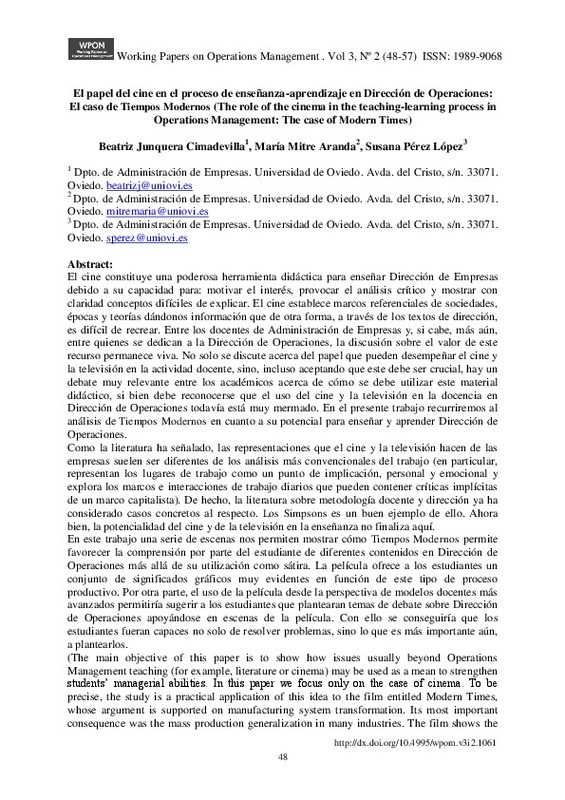Arnheim, R. (1957). Film as art. Berkeley/ University of California Press.
Carroll, N. (1985). The power of movies. Daedalus, Vol. 114, pp. 79-103.
Champoux, J. E. (1999). Film as a Teaching Resource. Journal of Management Inquiry, 8(2), 206-217. doi:10.1177/105649269982016
[+]
Arnheim, R. (1957). Film as art. Berkeley/ University of California Press.
Carroll, N. (1985). The power of movies. Daedalus, Vol. 114, pp. 79-103.
Champoux, J. E. (1999). Film as a Teaching Resource. Journal of Management Inquiry, 8(2), 206-217. doi:10.1177/105649269982016
Considine, D. M. (1989). The Video Boom’s Impact on Social Studies. The Social Studies, 80(6), 229-234. doi:10.1080/00220973.1945.11019951
Fails, E. V. (1988). Teaching Sociological Theory through Video: The Development of an Experimental Strategy. Teaching Sociology, 16(3), 256. doi:10.2307/1317527
Hassard, J., & Holliday, R. (s. f.). Introduction. Organization–Representation: Work and Organization in Popular Culture, 1-16. doi:10.4135/9781446280287.n1
Hobbs, R. (1998). Teaching with and about film and television. Journal of Management Development, 17(4), 259-272. doi:10.1108/02621719810210136
Messaris, P. (1994). Does television belong in the classroom? Cognitive consequences of visual 'literacy'. En Deetz, S. (Eds.): Communication Yearbook 17. Newbury Park/Sage Publications.
Moore, D. S. (1993). The Place of Video in New Styles of Teaching and Learning Statistics. The American Statistician, 47(3), 172-176. doi:10.1080/00031305.1993.10475970
Phillips, N. (1995). Telling Organizational Tales: On the Role of Narrative Fiction in the Study of Organizations. Organization Studies, 16(4), 625-649. doi:10.1177/017084069501600408
Postman, N. (1985). Amusing ourselves to death. Nueva York/Vicking.
Proctor, R.F. II (1990). Interpersonal communication and feature films: A marriage worth of a course. Michigan Association of Speech Communication Journal, Vol. 25, pp. 1-12.
Proctor, R. F., & Adler, R. B. (1991). Teaching interpersonal communication with feature films. Communication Education, 40(4), 393-400. doi:10.1080/03634529109378863
Rhodes, C. (2001). D’Oh. Journal of Management Inquiry, 10(4), 374-383. doi:10.1177/1056492601104010
Rhodes, C. (2002). Coffee and the Business of Pleasure: The Case of Harbucks vs. Mr. Tweek. Culture and Organization, 8(4), 293-306. doi:10.1080/14759550215611
Shields, D. C., & Kidd, V. V. (1973). Teaching through popular film: A small group analysis ofthe Poseidon adventure. The Speech Teacher, 22(3), 201-207. doi:10.1080/03634527309378016
Torre, S. De la, Oliver, C., Violant, V., Tejada, J., Rajadell, N y Girona, M. (2003-2004). El cine como estrategia didáctica innovadora. Metodología de estudio de casos y perfil de estrategias docentes. Contextos Educativos, Vol. 6-7, pp. 65-86.
Weinstein, D. (1998). The Simpsons and the postmodern. En Esposti, C.D. (Eds.): Postmodernism in the cinema. Nueva York/Berghahn Books, pp. 61-72.
Winegarden, A. D., Fuss‐Reineck, M., & Charron, L. J. (1993). Usingstar trek: The next generationto teach concepts in persuasion, family communication, and communication ethics. Communication Education, 42(2), 179-188. doi:10.1080/03634529309378924
Zorn, T. E. (1991). Willy Loman’s lesson: Teaching identity management withDeath of a Salesman. Communication Education, 40(2), 219-224. doi:10.1080/03634529109378843
[-]








